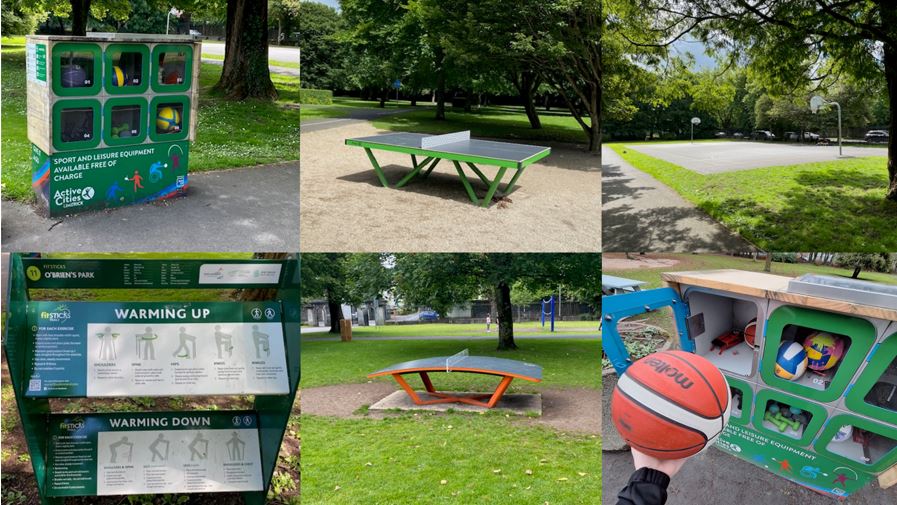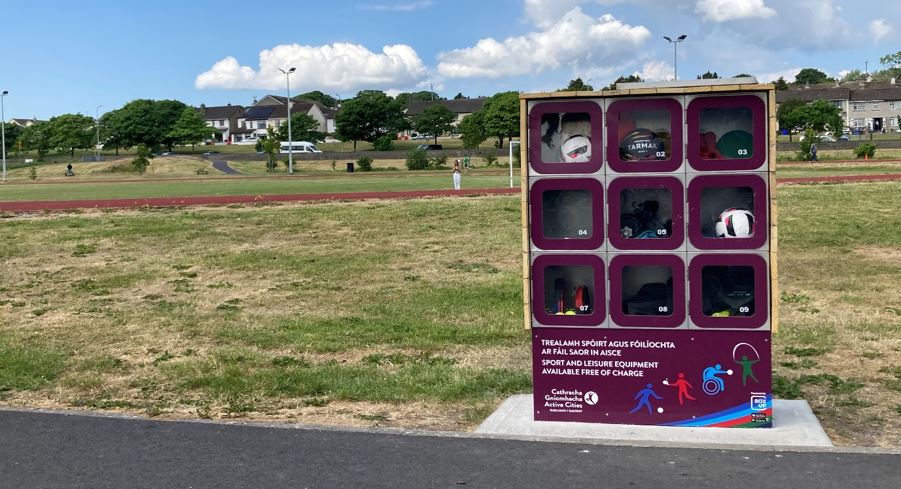
Play and sports equipment lockers are a simple and effective solution to get people moving
Public parks and open spaces hold immense potential as hubs for physical activity, community connection, and informal play, but too often that potential goes unrealised. While investments in infrastructure like courts, paths, and green areas are important, they don’t always guarantee use by the local community. What’s often missing is access to the simple tools of play: balls, rackets, fitness gear, and games that invite people of all ages to get active.
What’s often missing from green space is access to the simple tools of play: balls, rackets, fitness gear, and games.
Across Ireland and beyond, the implementation of sports equipment lockers is reimagining how public space can better serve communities – by making it easier, more spontaneous, and more inclusive to be active. One example is BoxUp, a locker system that offers free, app-based access to shared play and sports equipment, helping to bridge the gap between infrastructure and participation.
What is BoxUp?
BoxUp is a solar-powered locker system that offers free access to play and sports equipment for the public. The selection includes gear for ball and racket sports, fitness tools like resistance bands and dumbbells, as well as recreational games such as pétanque, cornhole and more.[1] The selection can be tailored to fit the surroundings – for example, offering basketballs near a court or frisbees in open park areas. Users can access the equipment using a smartphone and the BoxUp app, with no credit card required.
The majority of BoxUp stations in Ireland require the same floor space as a park bench.
BoxUp units have been installed in a number of cities across Europe and Canada.[2] They vary in size from as small as a 2 locker unit up to a 12+ locker unit. The majority of BoxUp stations in Ireland contain 6 individual lockers and require the same floor space as a park bench. Each unit comes with a service agreement that includes app support, and the lockers all contain shatter-proof glass panels to ensure its durability. BoxUp lockers have a return rate of 99% and in the event of equipment being stolen, user accounts are reported and may be banned.[3]
BoxUp lockers have an item return rate of 99%.
Growing Impact Across Ireland
In a push to foster healthier, more active communities, five cities in Ireland – Dublin, Cork, Limerick, Galway and Waterford – have undertaken an innovative approach to public space activation through BoxUp, a locker system offering free access to play and sports equipment. Supported by Sport Ireland under the Active Cities initiative, the project reflects a broader national effort to transform how public spaces are used and shared while also prioritising disadvantaged communities.
Between July 2023 and March 2025, over 6,000 users across Ireland engaged with BoxUp lockers, demonstrating significant demand and interest. Of the 29 Local Sports Partnerships (LSPs) in Ireland, eight have adopted BoxUp, using funding from the Active Cities initiative to support its implementation. The success of these early adopters has sparked increased awareness of the importance of providing not just infrastructure but also access to play and sports equipment, particularly in communities where such access is limited.
For many local councils, adding play and sports equipment lockers fills a critical gap in public space activation. As Mary Corry, National Active Cities Officer puts it:
‘Local Authorities are spending on infrastructure, but what’s missing is the equipment. We know that for some, accessing equipment can be a real barrier to their participation, and with so many facilities, parks and open spaces, it’s important we try to meet the needs of individuals to enable them to be active, and increase usage of the available infrastructure.’

Image from Mary Corry
Those who install and provide BoxUp stations in a community can access aggregated data through an online dashboard. This data enables local authorities and other providers to fine-tune options and better understand who is using the equipment and how.
In a 2024 survey that was completed by over 500 BoxUp users across Europe, it was found that 65% of respondents did not have the BoxUp equipment at home.[4] Installing play and sports equipment lockers removes this barrier, opening up opportunities for physical activity – both planned and spontaneous – across park spaces.
A recent survey of BoxUp users found that two thirds of respondents did not have the BoxUp equipment at home.
Moreover, the lockers offer a flexible and responsive solution, as equipment can be changed based on community feedback via the app. Local Parks Departments and other stakeholders have also noted how the visible presence of play and sports equipment lockers helps them advocate for more funding, particularly when showcasing community engagement metrics.
Success hinges on selecting the right location. Local teams determine locker placement by reviewing potential parks and prioritising disadvantaged areas. This decision-making process involves collaboration across departments and direct community consultation to ensure the unit placement and equipment offerings reflect the actual needs of the community they serve.
Anti-social behaviour was a concern at first, but in practice was found to be manageable, as the benefits to the wider community far outweigh any minor issues which have arisen. Users who fail to return items due to foul play can be banned from the app, and replacements for lost or damaged equipment (capped at approximately €100 per individual locker per year) are delivered monthly. Each unit has a designated contact person for oversight, and there have only been a handful of cases where users were banned.
Intergenerational play has emerged as a key benefit, with older and younger generations engaging in shared activities along with reports of users socialising with new people.
The lockers themselves have become tangible community assets, frequently featured on social media and embraced by local families. Intergenerational play has also emerged as a key benefit, with older and younger generations engaging in shared activities along with reports of users socialising with new people because of the BoxUp lockers.
Key Lessons and Takeaways
From Ireland’s experience, several important lessons have emerged:
1. Early community engagement pays off
Engaging the community early in the planning and decision-making process builds trust and ensures that the end result reflects the actual desires and needs of the people who will use the space or equipment. Early engagement also helps identify any potential challenges or barriers that might otherwise be overlooked.
2. Don’t assume – ask
Planners and decision-makers may have the best intentions, but without direct feedback, there’s a risk of investing in equipment and lockers in spaces that do not align with what the community actually wants or needs. Community outreach and data monitoring allow for local authorities to make informed decisions and avoid mismatches.
3. Free access to play and sports equipment promotes healthy lifestyles
When shared play and sports equipment is accessible to everyone, it promotes physical activity and social interaction across all age groups and backgrounds. This can lead to increased activity levels, improved health outcomes, stronger community ties, and greater use of public spaces.
4. Usage metrics can guide future investment
Collecting data on which equipment is used in each locker can highlight what’s working well, what needs changing, and where future investments should be focused.
5. Collaboration is essential
Collaboration between departments ensures that all perspectives are considered and that benefits are maximised from sharing resources and expertise – particularly in the early stages of biding for funding and location scouting.
Potential for England and beyond – a case study of East Suffolk
East Suffolk became the first local authority in the UK to install BoxUp lockers in 2024. The installation programme was driven after Councillor George King visited Switzerland and was inspired by seeing active public spaces being widely used for sport and play.
The decision of where to place the boxes was influenced by a desire to increase activity in the most deprived areas of East Suffolk, areas where children often lack the resources to participate in informal sports and play. Funding support came through the Lowestoft and Northern Parishes Community Partnership that works with stakeholders to support community projects.

The primary aim of introducing the BoxUp lockers in East Suffolk was to eliminate barriers to physical activity, particularly financial ones, and offer individuals of all ages the opportunity to play freely, even when they cannot afford their own equipment.
As Councillor George King notes, it’s ‘such an easy way to get people of all ages out there doing sport.’
By stocking the lockers with a variety of play items, it aims to foster physical activity and informal learning, with future plans to include nature-related equipment, such as butterfly nets.
The availability of detailed reports, including postcode-level data, has helped to demonstrate the project’s impact.
Data collected through the BoxUp app has been crucial in demonstrating the project’s success and future planning. The availability of detailed reports, including postcode-level data, has made it easier to demonstrate the project’s impact, especially in underserved areas. Securing funding and aligning stakeholders was initially challenging, but the success of the project, seeing children being active and playing freely in public spaces has made the effort of those involved worthwhile. The initiative not only encourages activity and play but also ensures that sport and play in public space is accessible to everyone, regardless of background.
Conclusion
Provision of parks and public spaces is important for health and physical activity levels, but initiatives and activities to activate these spaces is vital. The potential for sports and play equipment lockers to transform under-utilised parks and public spaces into hubs of activity is significant. Initiatives like BoxUp encourage a fresh way of thinking about public space as an active environment that evolves with and reflects the needs of the community.
As more towns and cities consider ways to promote active lifestyles, play and sports equipment lockers offer a model that turns the simple act of borrowing a ball or racket into a gateway for social connection and physical wellbeing.
[1] https://boxup.app/equipment/
[2] https://boxup.app/locations/
